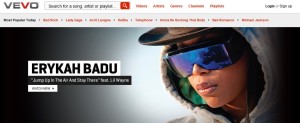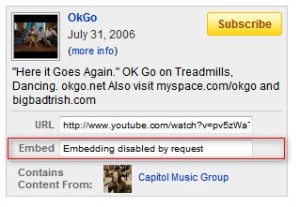The three mammoth record labels of Universal Music Group, Sony Music Entertainment and EMI joined forces a year ago to create a new video distribution site called Vevo.com. The site has been billed as the “Hulu.com for music videos”, and similar to Hulu, Vevo.com displays pre-roll and screen overlays on each music video with a top-tier advertiser. The goal of the site is not to replace YouTube for music video views, but to return revenue to the music industry from viral views. As YouTube is currently the go-to source for music videos, the big three wanted more control of their content. Eric Schmidt even attended their launch party back in December, so within Google the site is not seen as a threat, but rather a partner.
However, the cost benefits for the music executives can have increasingly negative effects on smaller music acts trying to break through to the “big time” by using embedded videos on sites such as YouTube. On February 19th Damian Kulash, lead singer of the band Ok Go, published an op-ed article in the New York Times which highlighted his frustration with EMI’s new strategy of disabling the embed function on their YouTube channel. Ok Go, best known for its ‘06 hit viral video “Here It Goes Again”, where the band dances in unison on treadmills, became popular through users embedding their YouTube video on other sites such as music blogs. The embed function on YouTube helped the obscure band garner tens of millions of video views on YouTube, which helped earn them a Grammy for the video’s song. While the label got free advertising and increased music sales off their new top 20 artist, they did not receive any revenue for those embed video views.
So began the Music Industry v. YouTube negotiations. In the past year, all three record labels involved with Vevo negotiated that YouTube would pay them a percentage of the advertising revenue for each view of their artists’ videos. In the negotiations it was also decided that the embed feature that helped many bands such as Ok Go get on the top 20 be removed from their artist pages.
The numbers are shocking:”When EMI disabled the embedding feature, views of our treadmill video dropped 90 percent, from about 10,000 per day to just over 1,000. Our last royalty statement from the label, which covered six months of streams, shows a whopping $27.77 credit to our account.”-Damian Kulash, NYT 2/19/2010
Looking at the industry’s past with paying DJs to “hype” their artist, it seems illogical to disable a feature that helps artists get heard, especially via targeted music blogs. Vevo was the big three labels’ solution to re-enable an embeddable format that users can use to share artist content virally, while retaining full control and creating another potential advertising avenue. Today, the labels’ apparent strategy is to use Vevo as the video management agency for all of their artists’ online video assets. Vevo’s strategy with YouTube appears to have changed in the past two months, to start to building awareness around their own site while still allowing some functionality for all worldwide users on YouTube. The benefit for Vevo(aka the big three) is they now have control of embeddable content while having two revenue generating marketing channels via both sites having embedded calls to action for purchasing songs via Amazon or Itunes.
While OkGo has decided to leave EMI based on EMI’s decision to “wring revenue out of everything we make, including our videos” many of the labels’ artists now have a [artists name]VEVO channel on YouTube with all the music videos from their previous profiles. Artists such as Beyonce still have their previous channel, but all favorite videos and the majority of links are now pointed to the beyonceVEVO channel. The future relationship between artists and YouTube will be interesting as Vevo currently only has a comment field for user interaction. Could Beyonce have the same success with “single ladies” on a platform that does not promote user interaction and user submitted versions of her video? Is the goal to have users watch videos on Vevo and then interact on YouTube?
What are your thoughts on Vevo.com and the music industry’s embargo of embeddable content on YouTube? Any predictions on Vevo.com’s success now that artists videos are linked with Vevo?






